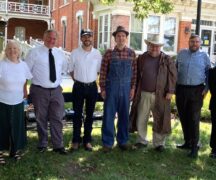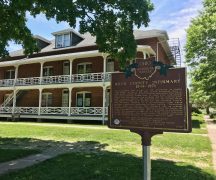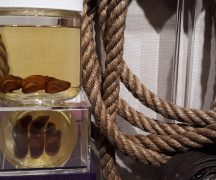By JAN LARSON McLAUGHLIN
BG Independent News
It’s been more than five months since frozen radiators turned into geysers at the Wood County Museum. The building – constructed in 1868 as the county’s infirmary for the aged, ill and poor – remains closed due to the extensive renovations still underway in the 30,000-square-foot building.
If the repairs proceed as planned, the museum could be open later in July, according to Director Annette Wells.
The good news is that while the building suffered water damage on all three floors, the exhibits on display and the artifacts in storage survived, Wells said.
The flood was discovered when museum staff returned to work after the Christmas holiday. They found water ponding on floors, leaking through ceilings, and running down walls.
Because of extreme cold temperatures and blustery winds over Christmas weekend, 11 of the building’s 82 radiators had frozen and burst.
“We did have quite a mess,” Wells said.
“This one was actually squirting out,” she said, pointing to a radiator in an archives room.
Wells said it was a heartbreaking sight. “The wind was just right to blow the furnace exhaust back, and blew out the pilot light. It was kind of an oddball thing that happened.”
In some areas of the museum, the subflooring could not be salvaged, old tile floors were flooded, the plaster was badly damaged, and the electric had to be replaced. Where possible the old tiles are being restored, plus new plaster is being applied, and new paint is added. As is done throughout the museum, several layers of paint have been revealed to discover the colors previously adorning the walls.
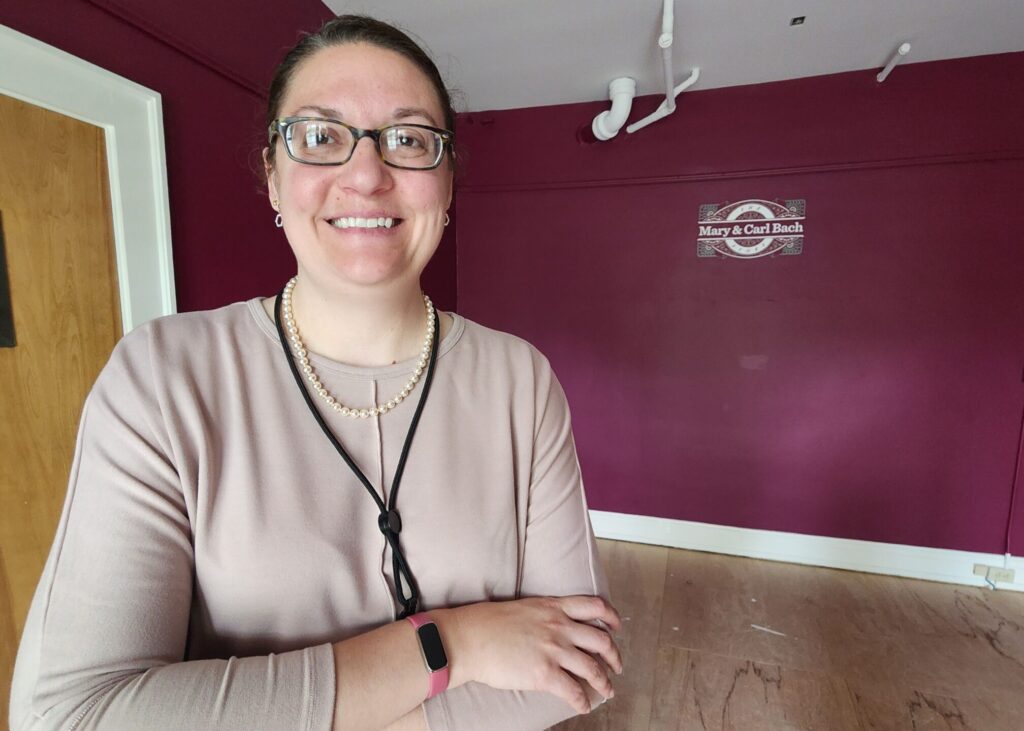
“We actually sand down and we pick an earlier color,” leading to a bright maroon coat of paint in the Mary and Carl Bach room, pale peach in an archives room, and a smoky gray in one of the wedding display rooms.
While the water damage to the building was devastating, the exhibits and stored artifacts were vastly unscathed, with only a few of the estimated 40,000 items needing deep cleaning.
The featured wedding/romance exhibit somehow survived – including the 40-plus wedding gowns dating back generations and on loan to the museum from local families.
“We just got so lucky that none of them had water damage,” Wells said.
The dresses are now covered with cotton muslin fabric until the museum opens. “We don’t want dust to affect the gowns,” she said.
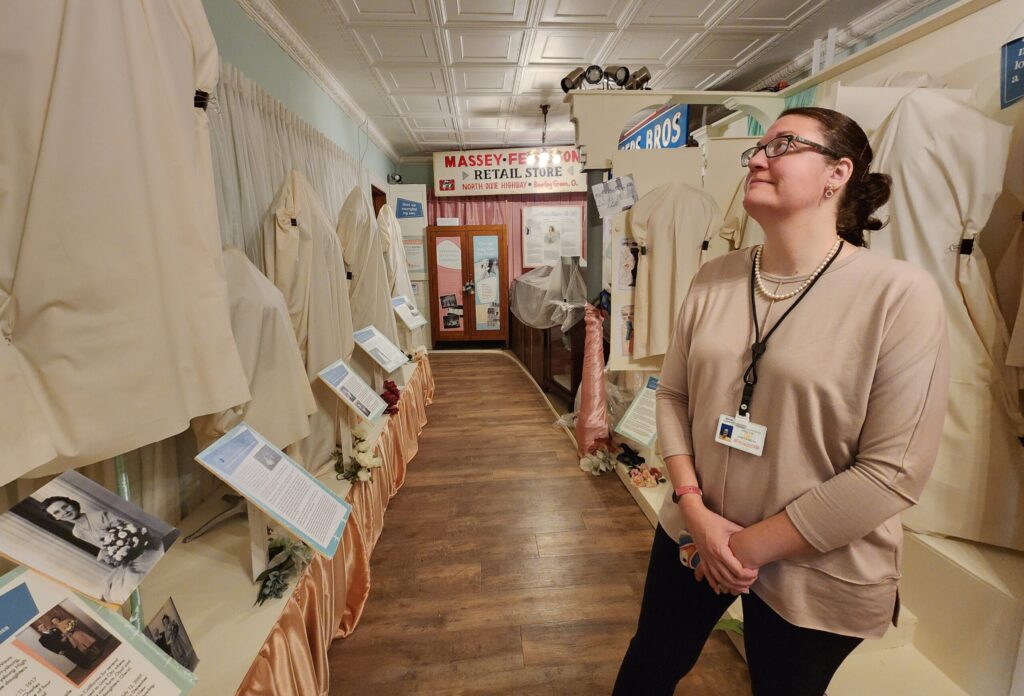
Some of the frames around artwork donated by the BGSU Pop Culture Department for the romance exhibit were damaged by water – but the art itself was spared.
The funeral exhibit at the museum had recently been put away, so the coffin, piano and chairs were not harmed.
“Out of sheer luck, we had taken that down before winter. Otherwise it would have been filled with water,” she said of the piano.
The archival rooms survived, a relief to staff since the records include information on all the residents who lived at the county infirmary.
“Some of the boxes got wet, but we didn’t lose anything,” Wells said.
Up in the third floor attic storage wings, the burst radiators sent water across the floors and cascading to the first and second floors below.
“The water went everywhere here,” she said. “It was like a monsoon.” In one attic closet, an inch of water turned to ice.
But recently purchased and installed museum storage units saved the artifacts on the top floor. Prior to the new storage system, items such as old garments were draped on tables, often touching the floor, Wells said. Other antiques were stacked on the floor.
“Everything would have been ruined,” she said.
But the storage units kept artifacts high and dry, and huge fans got the dampness out of the wood floors.
“You can see how valuable this is,” Wells said, pointing to the new shelving.
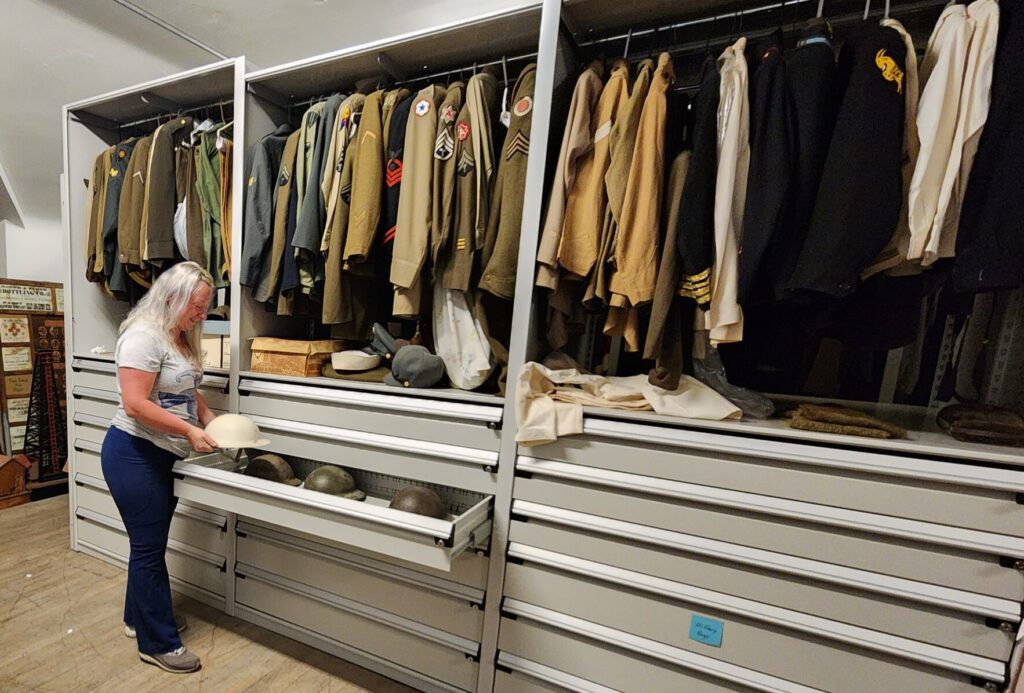
The cost of repairing the water damage is estimated at $70,000. The museum is a partnership between the Wood County Commissioners and the Wood County Historical Society – both which have insurance for such incidents. Since the county owns the building, its policy is paying to repair the building. And since the historical society owns the collections, its policy will help with damaged items.
“We have been doing some fundraising to help,” Wells said. But the customary revenue of the summer season isn’t coming in, she added. “Normally right now, we’re open,” hosting events and tours.
“The numbers this year will be all out of whack,” she said. “We thought we could kick things into high gear after the pandemic. But this has definitely set us back this year.”
Wells is hopeful the new flooring will be in place by the end of June, then the exhibits can be put back on display in July. A celebration may be held in August to open up the museum to the public.
But until then, the museum staff wants the public to visit the other features on the site – the herb gardens, the “lunatic asylum,” the “pest house,” ice house, hog barn, chicken coop and privy.
The museum is the best preserved county infirmary site in the state.
“We want to take care of these buildings the best we can,” Wells said.

To that end, some changes have been made at the museum to make sure nothing like this happens again. When the boiler went out in the building last winter, the security service reportedly called the staff to alert them, but said the alarms were likely going out because of the power outage.
Provisions are now in place to keep the boiler light from being blown out, and county employees will check on the buildings during long weekends when the museum is unoccupied.
“Lessons learned,” Wells said.
Some new discoveries were made during the repairs of the historic structure. When a hole was cut into the ceiling of an east wing room, which is newer than the first 1868 construction, a signature was found on a board.
“One of the day laborers signed his name when it was built,” Wells said, pointing up to James Osborne’s signature with the date of 1898. “It’s kind of neat that we found that.”
Other ceilings concealed different treasures. “We also found rolling paper and tobacco,” she said. And in one spot, a portion of the ceiling will be left open so museum patrons can get a glimpse of the basic construction used – with no insulation.
“It’s wood, brick and plaster. That’s it,” Wells said.
Much of the brick used started out on grand local homes, then was repurposed to build the former county infirmary.
“This is the poor house. They weren’t using brand new things,” she said. “They would have built it as strong as they could for that time.”


